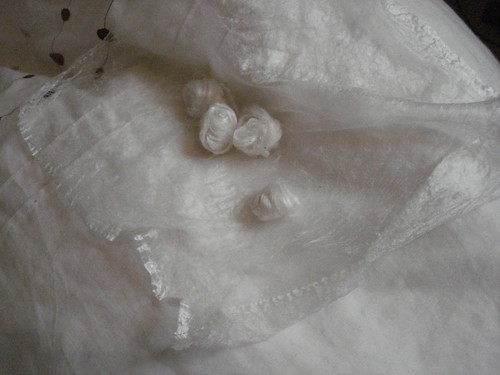Since I've gotten so many new fibers lately, several of them undyed, I have been itching for the dyepot. All my old tools are still in Ohio - my no-food pots and pans, my citric acid, my old formulas, my many boxes of food coloring - so I'll probably pick some of that up when I visit the States in the summer. Until then, I'm investigating some other dye methods - first up is turmeric.
Turmeric is a yellow-orange spice mostly found in Indian cooking. The upside of this dye process is that afterwards, your house smells of an Indian restaurant ;)

I started with about 35g of silk hankies, which I rolled up burrito-style - the idea was to get some uneven dye absorption, for a semisolid effect.
I soaked them in water for just a few minutes, then turned the heat up and waited for a boil. I added a few spoonfuls of turmeric to the mix, and stirred it all around.
After a minute or two of boiling, and after all the dye had exhausted, I washed it out and let the silk dry. What was my result?

A BRIGHT, SUNNY yellow. I couldn't be more pleased with that color; it's just what I need for the end of winter and beginning of spring.
There were a few downsides to this dye session, however - stirring the hankies around left them a bit matted at the edges, so it's harder to separate them. There is still a little bit of powdered turmeric left in the folds and corners, as well. Also, I have read that turmeric is not a very colorfast dye - this yellow will probably fade over time.
~Joyuna

 The Grateful Crane Shawl
The Grateful Crane Shawl Elven Slippers
Elven Slippers Russell Square Mitts
Russell Square Mitts Russell Square Tam
Russell Square Tam iTouch Jumper
iTouch Jumper Twisty Wristband
Twisty Wristband Mawata Pulsewarmers
Mawata Pulsewarmers
I have just started in the world of dyeing . . . attended a workshop a few weeks ago on vegetable dyeing . . . ohhhh so interesting! Enjoyed reading through your blog. Will add you to my own meager blogroll - will look forward to more of your posts.
ReplyDeleteScott
http://www.thehandweaver.com/wordpress